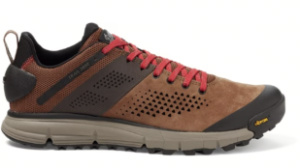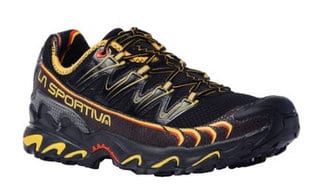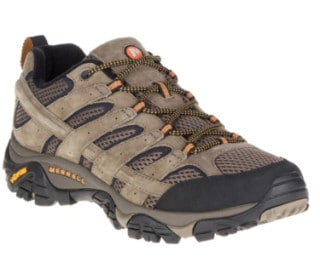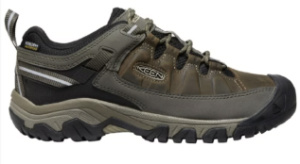Hiking shoes and trail runners are the most popular footwear used by hikers and backpackers today. The biggest difference between the two is that hiking shoes, which tend to be heavier and more durable, can only be used for walking while trail runners can be used for walking and running. Given their popularity among hikers, it makes sense to list them together, so you can weigh their pros and cons.
Preferences vary widely, however, and some hikers like waterproof footwear, ones with thick cushioning, more durable hiking shoes, or ultralight mesh trail runners that dry rapidly when they get wet. Regardless of your preferences, it’s important to choose footwear that fits well and is appropriate for the conditions you plan to hike in, especially in terms of temperature, terrain difficulty, and the weight of the loads you expect to carry.
Here are the 10 best hiking shoes and trail runners that we recommend.
1. Danner Trail 2650 GTX Hiking Shoes
2. Altra Lone Peak 7 Trail Runners

- Type: Trail Runner
- Cushion: Medium
- Drop: 0 mm
- Wide Sizes: Yes
- Durability: Average
The Altra Lone Peak 7 is the most popular trail running shoe used by thru-hikers by a wide margin. Noted for its roomy toe box, splayed forefoot, and integrated tongue, the moderately cushioned Lone Peak has mesh uppers for enhanced breathability and drainage. This zero-drop shoe has a toothy lugged sole that provides good traction, with an integrated rock guard that offers enhanced forefoot protection. An innovative gaiter trap on the rear of the shoe holds your gaiters in place. Durability can be so-so if you hike in rocky terrain which abrades the shoe’s mesh outers, and sand may leak inside in desert terrain. If you’ve never worn a zero-drop shoe before, they take some time…on the order 4-6 weeks to acclimate to as they alter your stride and can put strain on your calf muscles and Achilles tendon.
3. HOKA ONE ONE Anacapa Low GTX Hiking Shoe

- Type: Hiking Shoe
- Cushion: High
- Drop: 6 mm
- Wide Sizes: Available
- Durability: Excellent
The Anacapa Low GTX is a hiking shoe that combines the enhanced durability of a hiking shoe with the performance of a trail runner. Waterproof, low-profile, grippy, and light, their nubuck leather outers and Gore-Tex lining provide enhanced durability and moisture protection. Compression-molded EVA midsoles provide a balanced, cushioned, and stable ride that resists ankle rolling while their extended heel geometry and enhanced front rocker allow for smoother heel-to-toe transitions and easier push-off. The Anacapa Low GTX has Vibram Megagrip soles and 5 mm lugs that provide good traction on hard dry surfaces but can be a little sloppy for serious scrambling and edging. The durability of these shoes is quite good, however, due to their nubuck leather outers which should keep them on the trail for multiple seasons.
4. La Sportiva Ultra Raptor II Trail Runner
5. Merrell Moab 3 Hiking Shoes
6. Hoka ONE ONE Speedgoat 5 Trail Runner

- Type: Trail Runner
- Cushion: Maximum
- Drop: 4 mm
- Wide Sizes: Available
- Durability: Average
7. Salomon X Ultra 4 GORE-TEX Hiking Shoes

- Type: Hiking Shoe
- Cushion: Moderate
- Drop: 11 mm
- Wide Sizes: Available
- Durability: Excellent
The Salomon X Ultra 4 Gore-Tex shoes are rugged shoes that can be used for day hikes and backpacking trips across a wide range of terrain. They draw on Salomon’s trail-running expertise and share many of the properties and components of its nimbler trail runners, including the grippy ContraGrip outsole, the ADV-C support chassis, and the shoe’s unique quick lace system which you don’t tie but pull to tighten. While well built and envisioned, you’re either to love the X Ultra 4 or hate it because it’s a fairly stiff shoe with an internal shank, a deep heel cup than can irritate your ankles and because the quick lace system makes it difficult to modify the pressure of the laces in different spots along the top of the shoe. On the flip side, the X Ultra 4 is a lightweight hiking shoe with a roomy toe box, excellent traction, and good support. Try them: you might really like them.
8. Brooks Cascadia 16 Trail Runner
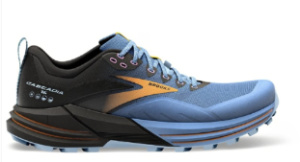
- Type: Trail Runner
- Cushion: Medium
- Drop: 8 mm
- Wide Sizes: Available
- Durability: Very Good
Now in its 16th iteration, the Brooks Cascadia 16 is an incredibly refined trail runner loaded with features that trail runners and hikers will find valuable. Combining cushioning with protection, channels in the midsoles and outsole construction let the shoes mold easily to the ground, improving a stable ride. A ballistic rock plate protects against pebbles and uneven terrain and the gusseted tongue keeps out sand and small debris. The shoes have a heel gaiter tab and a lace keeper so laces don’t untie when underway. Synthetic inlays on the front and along the side help protect the shoe’s exterior mesh from abrasion while drainage ports help evacuate water quickly. Deeply lugged are made with a sticky rubber provides excellent grip on both wet and dry surfaces. The Cascadia 16 is a great all-rounder that works in just about any terrain, providing stable comfort and traction.
9. KEEN Targhee III Waterproof Low Hiking Shoes
- Type: Hiking Shoes
- Cushion: Medium
- Drop: 8-10 mm
- Wide Sizes: Yes (Amazon)
- Durability: Excellent
10. Topo Athletic Terraventure 3 Trail Runners

- Type: Trail Runner
- Cushion: Medium
- Drop: 3 mm
- Wide Sizes: No
- Durability: Average
How To Choose Hiking Shoes and Trail Runners
There’s a lot of variety available when it comes to hiking footwear and ad people have a wide range of personal preferences. This is why we highly recommend that you try lots of different options if you’re making a new selection, so you can discover what your preferences are. Here are some guidelines about things you should consider when choosing between different hiking boots, trail shoes, and trail runners. For example, some thru-hikers can get an entire hike out of a pair of hiking shoes but will go through three or more pairs of trail runners to travel the same distance. That can get kind of expensive, as you can imagine.
Hiking Shoes vs Trail Runners: What’s the Difference?
Hiking shoes are really just meant for walking, while trail runners can be used for walking or running. That’s probably the simplest definition. The truth is there is a lot of overlap between the categories. In general however, you’ll find that hiking shoes are heavier and more durable, while trail runners wear out much more quickly because they’re lighter weight and made with less durable materials.
Sweat can lead to blisters
The buildup of sweat inside of hiking footwear and your socks can lead to blisters. When your socks stick to your skin, they can cause friction, and a friction burn, which is how blisters form. Breathability is key to preventing sweat build-up, which is why so many hikers prefer mesh hiking footwear since it dries while you wear it.
Black toenails indicate a poor fit
If your toenails turn black when you hike, it’s because your toes do not have enough room in the front of your footwear. Size up or select footwear that has a larger toe box by design. Altra and KEEN shoes and boots have an exaggerated-size toe box, which is why they’re so popular with hikers and backpackers.
After-Market Insoles
One-third of hikers and backpackers buy after-market insoles, such as Superfeet, to replace the insoles that come with their hiking boots, mids, trail shoes, and trail runners. These provide more protection, more arch support, and cup your heel to help prevent the lateral movement that can cause plantar fasciitis. They also last longer than factory insoles.
Waterproof/breathable footwear dries slowly
Waterproof/breathable footwear tends to dry much more slowly than non-waterproof footwear. While waterproof hiking boots and shoes are good for hiking in cold weather, it’s often more desirable to have a well-vented mesh shoe that dries quickly than one that stays wet for days and can lead to blisters and other discomforts.
Ankle Rolling
Many hikers opt for boots/mids because think they’re necessary for carrying heavier-weight backpacks and provide more ankle support than low hiking shoes or trail runners. While that was probably true when all hiking boots were made with heavy leather, modern hiking boots and mids are much softer and less supportive and are really just one step up from being trail or running shoes. While they can provide more assurance, you can still twist an ankle when wearing one. On the flip side, many hikers and backpackers are able to carry heavy packs and walk on rugged mountainous terrain in trail shoes and trail runners. In other words, there’s no right answer and you should decide for yourself, rather than follow anyone’s gospel truth.
Traction
Boot and shoe manufacturers make a big deal about traction and while it is important, it’s very difficult to prove that different sole compositions, lug angles, lug depth, Vibram or non-Vibram soles, blah, blah, blah, etc. make that big of an impact on traction. When push comes to shove, the only hiking traction that really matters is when you’re scrambling on wet rock or walking along a cliff edge. Even then, good footwork is probably more important, so develop that rather than relying on your shoes.
Toe and Foot protection
Hiking and backpacking can be tough on the feet, particularly around the toes and under the arch. It doesn’t affect everyone, but it can lead to injuries that take a long time to heal. Built-up areas around the toes, sometimes called toe kicks, are good if you hike in rocky terrain. A shank is usually a hard strip of nylon or plastic that runs under the arch and helps stiffen a shoe or boot. Rock plates and stone guards in the forefoot of the shoe provide additional protection from sharp stones that can bruise your feet, particularly when trail running.
Gaiters
Hikers wear gaiters to block sticks, stones, and other debris from getting into their shoes while they hike. But some shoes are more gaiter compatible than others. For example, if your gaiters have a strap that loops under your shoe, you’re going to want to have footwear that has an arch, so the gaiter strap doesn’t get destroyed by rubbing on the ground. Gaiters designed for trail shoes or trail runners may require gluing a velcro strip to the back of your heel to hold the gaiter in place. If this is the case, make sure there is a flat surface on the back of the heel so you can glue the velcro strip to it.
Wide Shoe Sizes
About 1/3 of all hikers require footwear in wide widths. Companies such as Merrell, KEEN, Brooks, and Vasque have the best selection of wide-width hiking footwear.
Check Out All of SectionHiker’s Gear Guides!
SectionHiker is reader-supported. We independently research, test, and rate the best products. We only make money if you purchase a product through our affiliate links. Help us continue to test and write unsponsored and independent gear reviews, beginner FAQs, and free hiking guides.

